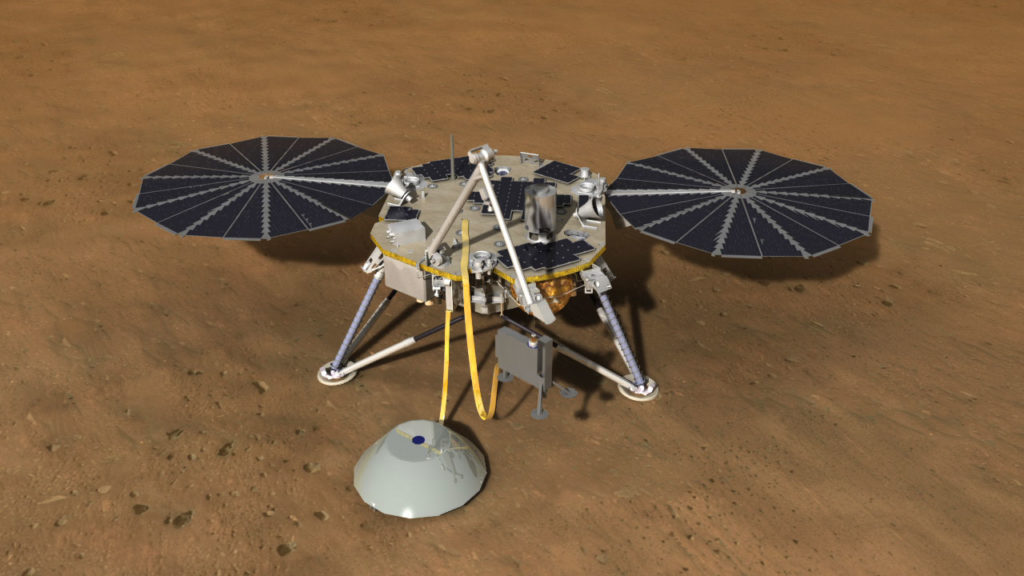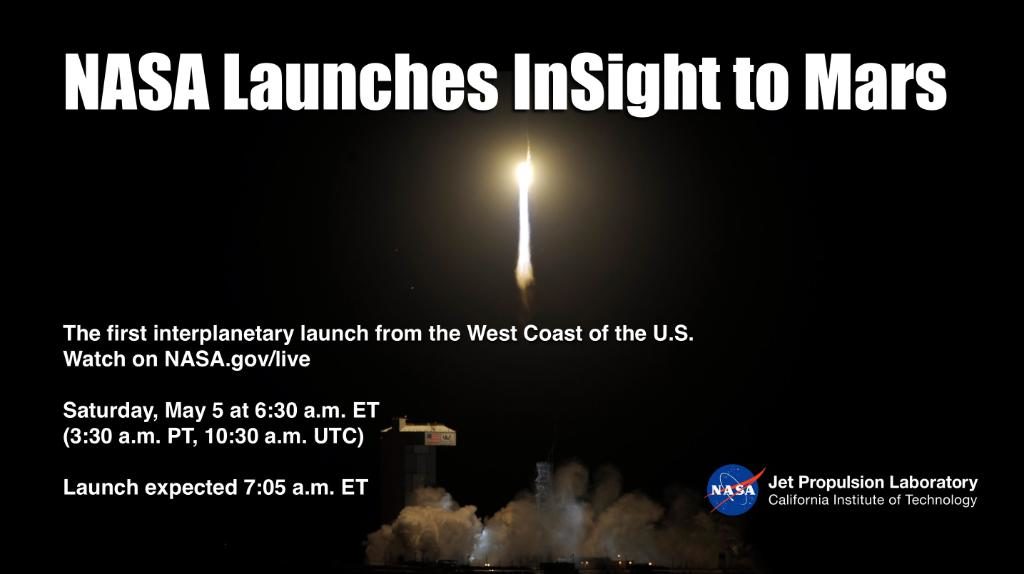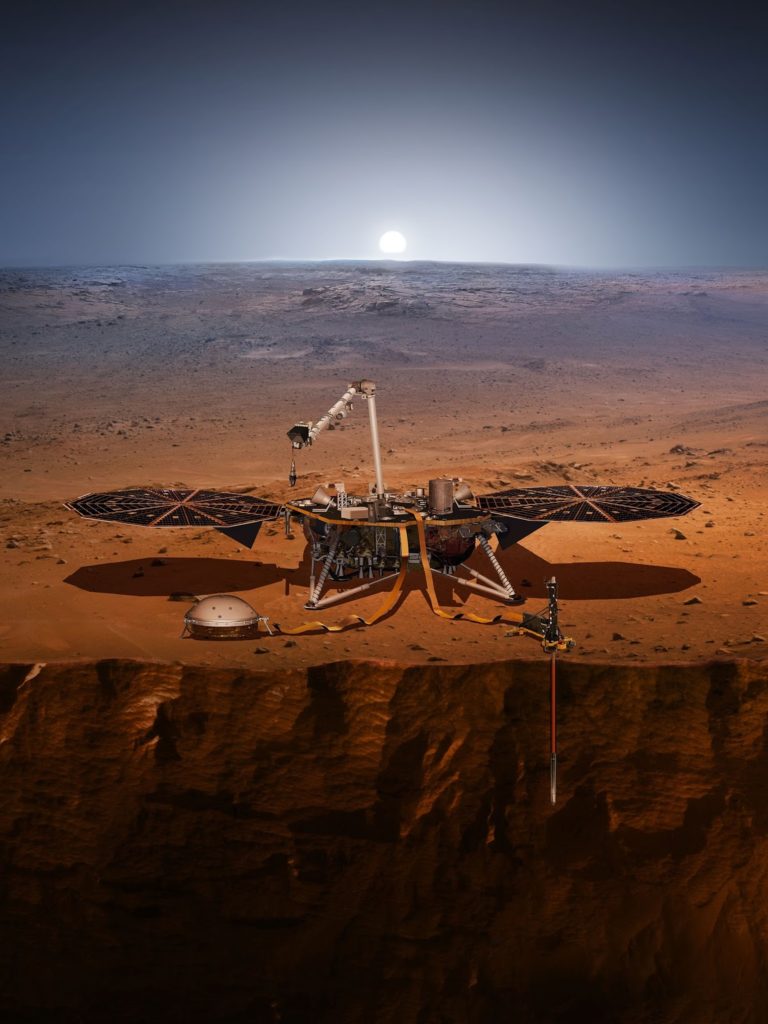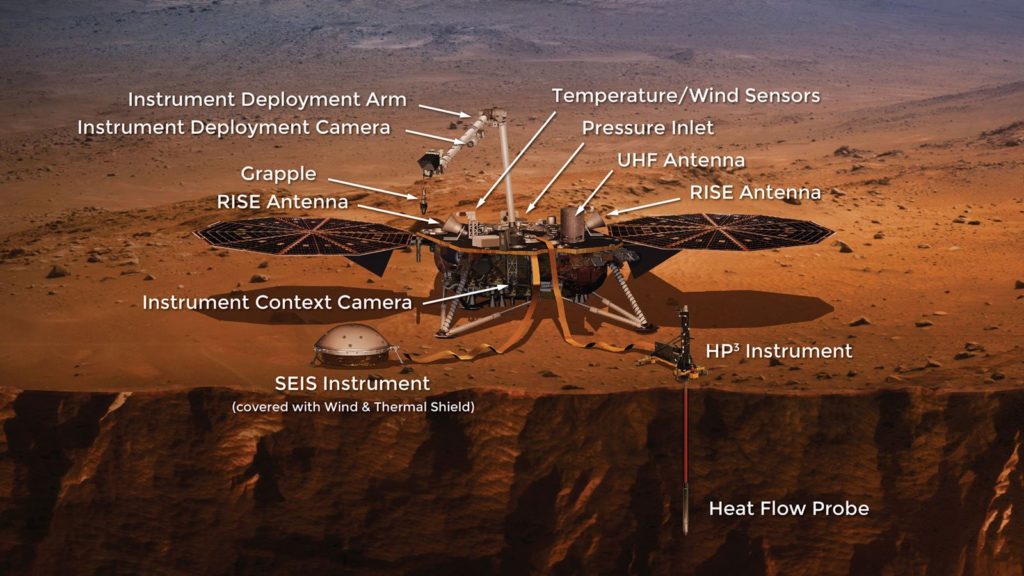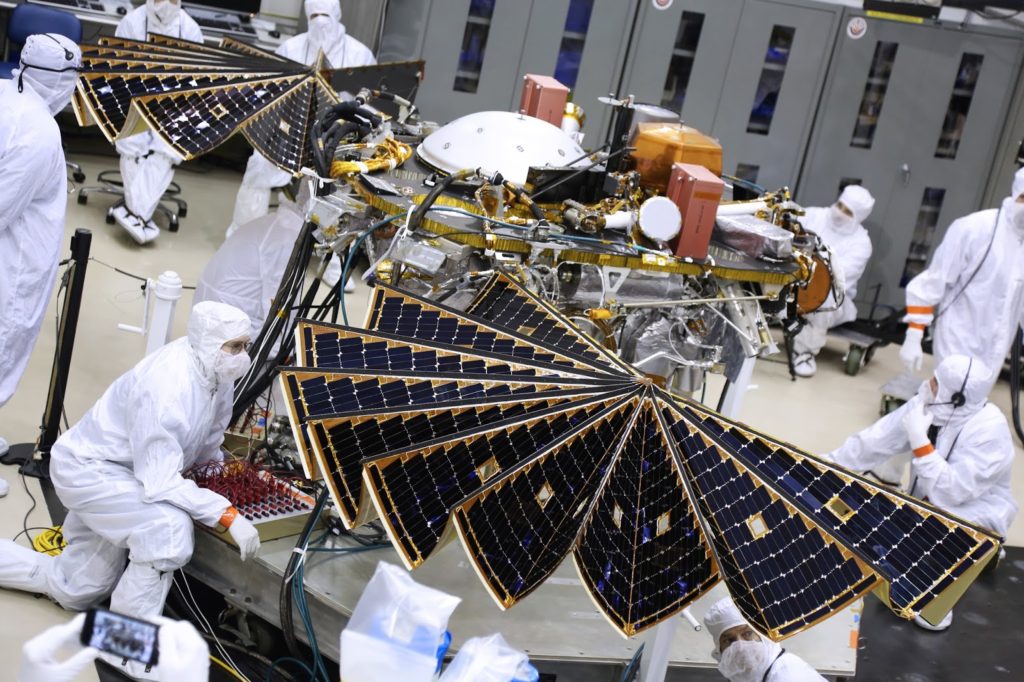CANAVERAL, FL – NASA’s
InSight Mars lander is ready for blastoff to the Red Planet on Saturday, May 5,
or Cinco De Mayo atop a United Launch Alliance Atlas
V rocket in the dead of night from California.
interplanetary probe on a mission to study the deep interior of the Red Planet.
It is equipped with two state of the art science instruments and also help us understand
how the Earth evolved after its formation
phase to take the “vital signs” of the Red Planet and measure “Marsquakes” will last for a full
Martian year (2 Earth years) after touchdown. And if all goes well, the mission
will continue beyond !
Liftoff of NASA’s InSight
lander is slated for May 5 aboard a United Launch Alliance (ULA) Atlas V 401
rocket from the U.S. Air Force Vandenberg Air Force Base Space Launch Complex
3E.
interplanetary cubesats launching beyond Earth orbit
and towards the Red Planet named MarCO A and B (or
Mars Cube One) and nicknamed WALL-E and
Eva are also aboard. They are
technology demonstration experiments. If they survive the trip they will
relay EDL data from InSight as it plummets down to the Red Planet.
at 4:05 a.m. PDT (7:05 a.m. EDT) and remains open through 6:05 a.m. PDT (9:05
a.m. EDT). The overall launch window to the Red Planet lasts until June 8.
live on NASA TV stating about 35 minutes prior to liftoff on Saturday, May 5,
6:30 a.m. Eastern (3:30 a.m. Pacific):
PT on May 5.
cast available at:www.ulalaunch.com
The
weather forecast is only 20 percent GO as this time according to USAF weather forecasters
with the 30th AF weather squadron.
concern is Launch Visibility. However if NASA and ULA choose to
wave the constraint then the weather odds rise to 100%. However fog will limit
visibility in the immediate area.
probability of violating weather constraints for a 24 hour delay remain at 80%.
Exploration using Seismic Investigations, Geodesy and Heat Transport mission.
The goal is to accomplish an unprecedented study of the deep interior of the
most Earth-like planet in our solar system.
tectonic activity and meteorite impacts, study how much heat is still flowing
through the planet, and track Mars’ wobble as it orbits the sun. While InSight
is a Mars mission, it’s more than a Mars mission. InSight will help answer key
questions about the formation of the rocky planets of the solar system.”
countdown to launch starts on Friday, May 4 at 10:14 p.m. PDT (Saturday, May 5,
1:14 a.m. EDT).
later, at about 11:30 p.m. PDT (May 5, 2:30 a.m. EDT), the 260-foot-tall
(80-meter) Mobile Service Tower — a structure that has been protecting the
Atlas V launch vehicle and its InSight payload during their vertical assembly
— will begin a 20-minute long, 250-foot (about 80-meter) roll away from the
Atlas. Four hours and 25 minutes later, the launch window will open.”
rocket launches, but it is a whole different vibe when there is something
you’ve been working on for years sitting in the nose cone waiting to get hurled
beyond our atmosphere,” said Bruce Banerdt, InSight principal investigator at JPL.
“But as exciting as launch day will be, it’s just a first step in a journey
that should tell us not only why Mars formed the way it did, but how planets
take shape in general.”
is NASA’s first interplanetary mission to launch from the US West Coast and
could be visible to tens of millions of Californians – weather permitting.
this NASA Description:
of NASA’s interplanetary launches to date have been from Kennedy Space Center
in Cape Canaveral, Florida, in part because the physics of launching off the
East Coast are better for journeys to other planets. However, InSight will
break the mold by launching from Vandenberg Air Force Base in California. It
will be the first launch to another planet from the West Coast.”
the country will get to see an interplanetary launch when InSight rockets into
the sky. On a clear day, the launch may be visible from Santa Maria, Calif. to
San Diego, Calif.”
InSight’s pre-dawn launch (4:05 a.m.) may be visible for more than 10 million
Californians without a need for them to drive to a special location. Just wake
up early, check the InSight Website for assurance the launch is
still on schedule, go outside, look at the western sky, marvel at the rocket’s
flare as it travels southward, and cheer InSight bon voyage to Mars.”
inferno and terror experienced during InSight’s planned entry, descent and
landing:
researchers are experts in modeling and simulations for entry, descent and
landing, working on missions since the Viking lander in 1976. In this episode,
we explore the challenges of guiding landers like Mars InSight through the
Martian atmosphere for a safe landing. Watch InSight launch as early as May 5,
2018! Credit: NASA
7 months after liftoff the landing is scheduled for Nov. 26, 2018 at Elysium Planitia. The location is about 300 miles away from Gale Crater Crater – where NASA’s Curiosity rover landed in 2012.
the two primary science instruments provided by European partners: The SEIS
seismometer and HP3 heat flow
measuring instrument.
National d’Études Spatiales (CNES) – the French national space agency
equivalent to NASA. The other instrument
measuring heat flow from the Martian interior is provided by the German
Aerospace Center (DLR) and is named Heat Flow and Physical Properties Package (HP3).
(16 feet) deep into Mars pulling the science heat flow
cable tether along to make heat flow and
temperature measurements. It will pause multiple times along the way down
to make detailed measurements at different depths of heat flow from the planets core.
The mission was originally planned to launch in 2016, but was delayed 2
years after a leak was detected in the SEIS instrument. If failed to hold
vacuum which would have relegated it useless. The instrument was successfully repaired
by JPL engineers.
The cost of the two-year delay and instrument redesign amounted to $153.8
million, on top of the original budget for InSight of $675 million.
Lockheed Martin is the prime contractor for InSight and placed the spacecraft
in storage while SEIS was fixed.
lander, aeroshell and cruise stage.
the aeroshell 418-pounds (189-kilograms) and the cruise stage is 174-pounds
(79-kilograms) as well as 148 pounds (67 kilograms) of loaded propellant and
pressurant.
pounds (13.5 kilograms).
They are mounted on the Centaur upper stage. They will be deployed about 30
minutes after InSight separates from the Centaur, and about 1 minute apart.
is funded by NASA’s Discovery Program of low cost, focused science missions
along with the science instrument funding contributions from France and
Germany.
for Ken’s continuing onsite coverage of NASA, SpaceX, ULA, Boeing, Lockheed
Martin, Orbital ATK and more space
and mission
reports direct from the Kennedy Space Center and Cape Canaveral Air Force
Station, Florida.
Earth and Planetary science and human spaceflight news: www.kenkremer.com –www.spaceupclose.com –
twitter @ken_kremer – ken
at kenkremer.com


